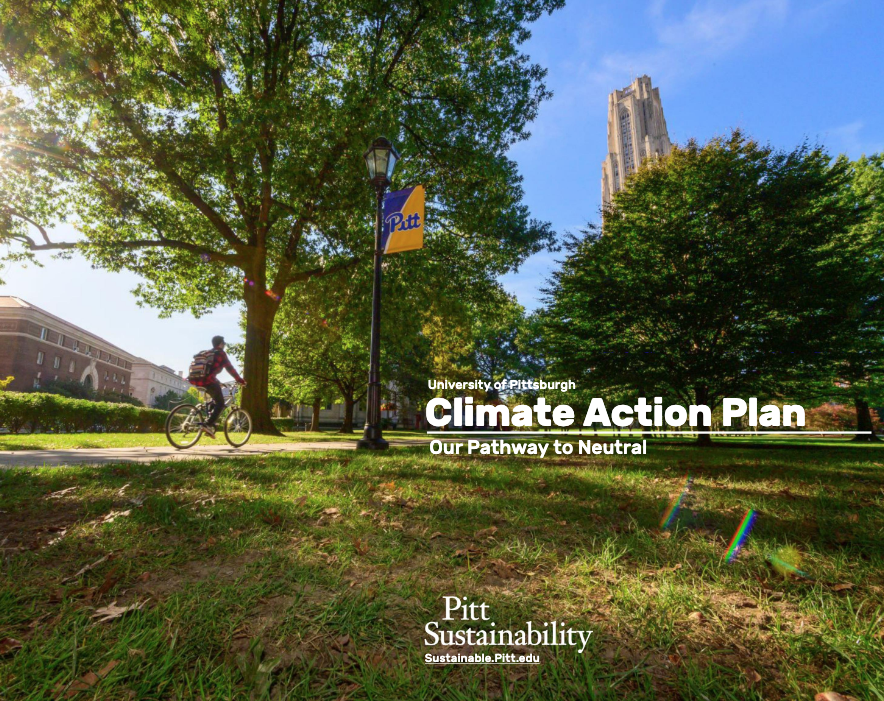‘Not soon enough’: Fossil Free Pitt criticizes Pitt climate action plan
March 31, 2022
Aurora Sharrard, Pitt’s sustainability director, believes the time for the University to reduce its greenhouse gas emissions is now.
“We are in a global climate emergency — that is a clear call to action,” Sharrard said. “Universities, governments, corporations and individuals around the world agree that we must all reduce greenhouse gas emissions while addressing the dangers that climate change presents for communities and the world.”
The University released its first-ever climate action plan, also known as the PittCAP, on March 17. The Carbon Commitment Committee of the Chancellor’s Advisory Council on Sustainability developed PittCAP to build upon the existing Pitt Sustainability Plan.
The PittCAP outlines a plan for Pitt to go carbon neutral by 2037, a timeline that the Board of Trustees committed to in February 2020. The University intends to get halfway there — reducing greenhouse gas emissions to 50% below 2008 levels — by 2030.
The University’s plan is split into three greenhouse gas mitigation priorities — energy demand reductions, clean supply and low carbon connections. The plan also designates three themes to cut across these efforts — enhancing Pitt’s academic mission, advancing equitable action and ensuring economic resilience.
The PittCAP aims to reduce energy consumption through efficient use of campus spaces, energy efficiency in existing buildings and new building performance. The University plans to undertake a campus space utilization and optimization study, and continue existing efforts to reduce energy consumption.
To clean Pitt’s energy supply, the PittCAP emphasizes district energy infrastructure efficiencies, cleaning of the electricity grid, existing local renewables purchasing agreements and future renewables generation and procurement. The main focus will be on electricity and thermal energy sources.
Cameron Chase, a junior environmental studies major and managing director of the Student Office of Sustainability, said the SOOS is excited to educate students about the new Gaucho Solar project and the Allegheny River Lock and Dam No. 2 hydro facility, which are included in the PittCAP.
“With Pitt directly getting electricity from renewable sources in the near future, this provides the SOOS with the opportunity to educate the Pitt community about the importance of renewables right here in Pittsburgh,” Chase said.
The low carbon connections priority focuses on reducing or offsetting the emissions from the commute of students and employees to campus and air travel for business and study abroad. The PittCAP describes expanding on-campus electric vehicle charging, encouraging commuters to switch to low-carbon mobility options, avoiding commutes via remote work options and creating an air travel carbon offset strategy.
To ensure that the PittCAP is executed on schedule, Sharrard said the Mascaro Center for Sustainable Innovation will continue its annual reports on the University’s progress. The reports are posted online as well as on the Pitt Sustainability Dashboard. The PittCAP will also be updated every five years, according to Sharrard.
Fossil Free Pitt said in a statement that the plan is “disappointing, to say the least.” They said while they are glad the PittCAP acknowledges the need for equitable outcomes in climate action, parts of the plan rely too much on carbon offsets and individual action.
According to the statement, the PittCAP’s focus on carbon neutrality itself is a problem and the real focus should be on fossil fuel divestment.
“What does it matter if Pitt’s campus itself is carbon neutral if we are still invested in the companies that are providing fossil fuels to the rest of the world?” FFPC said. “We want divestment, not carbon neutrality. The former is a means of revolutionary change, the latter a trending buzzword.”
The PittCAP’s pathway to carbon neutrality by 2037 does not take fossil fuel investments into account. According to the report, “it is uncommon to count the emissions from these investments in campus inventories, because they are already accounted for by public and private companies that provide financial services, such as banks and credit agencies.”
As long as the PittCAP does not include plans for divestment from the fossil fuel industries, FFPC said it is “not worth much.”
“It’s like this — if a house is burning down, and someone has only a cup of water to try to put the fire out, then that’s a noble, even heroic gesture,” the statement said. “But if someone has a whole tank of water, but only provides a cup, that’s pathetic. And if they’re profiting from the house burning down while they only offer that one cup? That’s morally repugnant.”
Sharrard, in response to the comments from Fossil Free Pitt, said the PittCAP is meant to be an update on the University’s goals and progress and not a fully detailed plan.
“The Pitt Climate Action Plan was not intended to capture everything that the Pitt community is doing, which includes vital research projects, education, advocacy and other activities,” Sharrard said. “Rather, it is an update on how we are addressing the direct impact of the University’s operations and our ongoing progress toward the critical goal of carbon neutrality by 2037.”
For Fossil Free Pitt, another issue with the PittCAP is its timeline. They said 2037, Pitt’s goal for reaching carbon neutrality, is too far away.
“Obviously, we don’t think that’s soon enough, but that’s not the half of it,” FFPC said. “In a report released earlier this year, the Intergovernmental Panel on Climate Change admitted that irreparable harm has already been done to the planet by the climate crisis. That’s not something happening in 2050 — that’s right now, in 2022, with 2037 more than a decade away.”
Sharrard said 2037 is “one of the most aggressive timetables for large, urban institutions in Pennsylvania.” She said while she wishes everyone would fight climate change faster, she is proud of the University’s timeline.
“While I always wish everyone everywhere was doing more to combat climate change and doing it faster, I am personally proud of the pace at which the University has embraced and elevated significant and thoughtful climate action,” Sharrard said.








